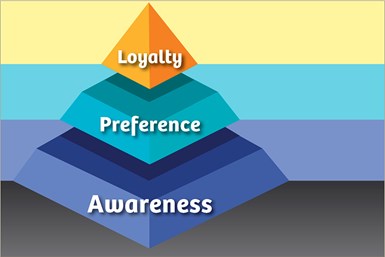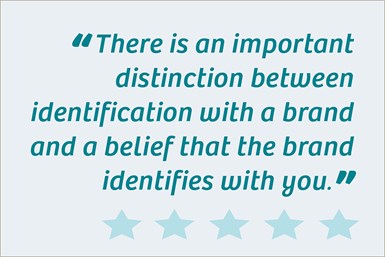Understanding Brand Affinity
An approach that seems to help understand customer behavior regarding brand loyalty and insistence is the work done by experts who look at customer brand involvement as a combination of involvement and emotional content. An understanding of customer behavior finds that insistence for brands will vary based on either the brand's personality or the brand's reflection of the buyer's personality. There is an important distinction between identification with a brand and a belief that the brand identifies with you.
#brandbuilding
Part 2 of a 3-Part Series
By Mitchell Goozé, Principal
Customer Manufacturing Group

Branding is a set of tactics to create brand awareness, reinforce brand positioning and build brand relationships. A "brand" itself is the shorthand mind-trigger that helps the prospective customer know, and the returning customer remember, what it is they are buying from your brand (product/service) that they are unable (or believe they are unable) to buy elsewhere.
Only the customer, though influenced by the producer and channel partner(s), measures a brand's value. A brand is a 'promise to meet a set of expectations.' Brand value to a customer may be positive or negative, and branding can be used to minimize the negative or accentuate the positive.
Brands move through levels of attachment or affinity with customers. Branding programs are designed to facilitate that movement. The first of these levels is brand recognition or brand awareness. At this stage the customer is simply aware of your brand and has no affinity. Until you have reached at least this first stage of awareness, your brand is irrelevant . . . regardless of its potential value.
How that first stage is reached varies by category and whether it is a business-to-business brand or a business-to-consumer brand. It should be clear that without at least recognition or awareness, the customer couldn't possibly become loyal or insistent. However, it is equally clear that recognition or awareness while necessary for loyalty or insistence is insufficient.
The customer may become fully aware of and recognize a brand that then evokes a negative response for that customer. That is, they are aware of the brand and reject it as representing a product or service they could want to buy or use. Whether this recognition and awareness is positive or negative and how to manage that result is beyond the scope of this article. For the time being we will assume that the customer has recognition/awareness, and this results in a favorable response.
Brand equity research firms have found that first recall awareness correlates to brand preference and brand loyalty. Really, they have found the converse to be true. That is, lack of "first recall awareness" correlates to a lack of brand preference and brand loyalty. If someone doesn't mention the brand first, they’re probably not brand loyal. That does not imply that if they do mention it first, they are brand loyal, however.
If, and that's a big question, the customer moves beyond brand awareness (recognition and comprehension), then the next step or level is brand preference. As the phrase implies, the customer has a "preference" for the brand. However, preference is defined (Random House) as: "the act of preferring" (that was helpful). Prefer is defined as: "to like better." But how much better? Unknown, and there's the issue.
Preference is certainly better than awareness (recognition and comprehension), but insufficient to result in loyalty and/or insistence. Preference won't get you shelf space for your product if you are a small supplier. Preference alone probably won't get the customer to go very far out of their way to buy your product or service. For that you need loyalty or maybe even insistence. So how do you move from weak preference to strong preference, which can then become loyalty and/or insistence?
Achieving Brand Loyalty

Brand loyalty is defined as someone who is faithful to one's brand allegiance. This level of brand attachment or affinity is highly desirable, but as described previously, can be hard to measure. Using persistence as the measure can mislead, as this behavior can appear to be loyalty, which has in fact only been "rented." True loyalty is an attitude. Attempting to measure attitudes solely by observed behavior has known deficiencies, and measuring attitudes is also subject to biases that measures of behavior are not.
Historically, some brand experts have suggested that migration from awareness to preference to loyalty occurs based on the creation of a brand personality. Brand personality is defined as the result of four dimensions:
1. Brand knowledge
2. Brand relevance
3. Brand differentiation
4. Brand esteem
The more effective a company is at each of these dimensions, the more "brand personality" and the higher the likelihood of brand preference and then brand loyalty. However, despite their apparent usefulness, these four dimensions have proven insufficient to predict or drive brand insistence.
Another approach that seems to help understand customer behavior regarding brand loyalty and insistence is the work done by experts who look at customer brand involvement as a combination of involvement and emotional content.

An understanding of customer behavior finds that insistence for brands will vary based on either the brand's personality or the brand's reflection of the buyer's personality. There is an important distinction between identification with a brand and a belief that the brand identifies with you.
Similarly, low involvement purchases may not lead themselves to insistent (or even loyal) behavior. For a given product or service, do some customer groups view a brand with low involvement while another group could view the same brand with high involvement? Sometimes, but probably not often.
To be clear, different groups of customers will have varying degrees of involvement with a category. But those groups can be classified by their involvement across the entire category not just by brand. For example, for some pet owners, pet food purchase is a low-involvement activity. What's on sale is what is bought. If a particular brand is on special often enough, these low-involvement customers can appear to have brand loyalty. There is no involvement going on, other than to save money.
Conversely, a high-involvement pet owner could spend significant time researching the best possible brand for their pet. Or they could become convinced (perhaps by branding) that their pet has a high involvement with its pet food and therefore a caring owner should too.
So, a high involvement pet owner may buy the same brand as the low involvement owner, but for different reasons. The high involvement customer is unlikely to switch brands based on price. So, simply watching in-store behavior may or may not reveal the issues involved without additional insight.
To understand Brand Insistence, we will review Measuring Loyalty and Emotional Attachment with the intention to create insistence in Part 3 that will appear in the October 2021 issue.
Need more information?
Mitchell Goozé, Principal
Customer Manufacturing Group
225 Gregorgio Court
Reno, NV 89521
408-987-0140
LinkedIn
800-947-0140
Fax: 408-727-3949
About the Author
Mitchell Goozé
A recognized expert in marketing, innovation and leadership, strategic positioning, and customer relationships, Mitch Goozé has addressed groups throughout the world. Mitch is an experienced general manager and leader with operating experience in the high technology and consumer products industries. He has experience running divisions of large companies, as well as being CEO of mid-sized companies. Mr. Goozé was president of Teledyne Components, a division of Teledyne, Inc. for five years.
Mitch is a Certified Speaking Professional (CSP). Vistage, an international organization of CEOs, named him Marketing Resource of the Year. He was named Speaker of the Year 2001 by TEC UK.
Mitch was a major contributor to Future In Sight, (Macmillan, 1995) and has three books on marketing in print. He has been a member of Customer Manufacturing Group since 1991. Customer Manufacturing helps its customers increase marketing/sales performance through process improvement management.
RELATED CONTENT
-
In B2B Market Research, It’s About Quality, Not Quantity
Online market research tools offer a cost-effective way to gain insight into smaller B2B customer bases. In Part 1 of this 3-part blog, we covered the strategic underpinnings of market research for SMBs; the what and why. In part #2, we get down to the hows. Specifically, online survey best practices. Simple, well-defined questions can be deployed on a DIY basis. If more complex, a hybrid of DIY and professional assistance might be in order.
-
5 Reasons Why Relationship Marketing is Important in Business
Business has changed since social media has arrived on the scene. Businesses have to change their focus and concentrate on building relationships with people in order to empower their brand and build lasting relationships that will result in long term profits.
-
"Made in the USA" Podcast: Show for This Moment in U.S. Manufacturing
“Made in the USA,” is a six-part documentary-style podcast series that strives to uncover the hidden history of how manufacturing in the United States arrived at its current state and lays out where it can go from here.


